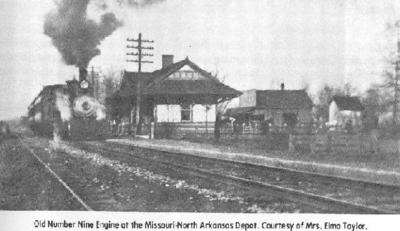TRACKIN’ DOWN THE PAST
Tom Pry
Those who’ve spent any time at all reading my burblings will realize that, among other things, I’m utterly fascinated with railroads, past and present. Besides being interesting, sometimes they’re the only thing left of some of our history.
For instance, at a few spots along EAST Pleasure Street, at street intersections,  before you get to Harding, there are still a few pieces of railroad track set into the streets, all that remains of a branch line of the Chicago, Rock Island and Pacific that ran from Hazen to the corner of Pleasure and South
before you get to Harding, there are still a few pieces of railroad track set into the streets, all that remains of a branch line of the Chicago, Rock Island and Pacific that ran from Hazen to the corner of Pleasure and South Main, where there was a depot, about on the spot where McKinney Supply sits now, across from Spring Park. Later, after the CRI&P stopped running here, the depot became the office for Railway Express (later REA Express), the now-dead precursor to UPS.
Main, where there was a depot, about on the spot where McKinney Supply sits now, across from Spring Park. Later, after the CRI&P stopped running here, the depot became the office for Railway Express (later REA Express), the now-dead precursor to UPS.
Around South Main and Beebe-Capps, there’s still a little trackage of the long-gone Missouri & North Arkansas, later defaulted to the DK&S. Up until the curve before Pleasure Street, in fact, there is strong reason to suppose that Beebe-Capps itself is built on the abandoned MN&A (aka the May Not Arrive) right-of-way.
And speaking of the Doniphan, Kensett, and Searcy Railroad (said he, cleverly leading us into the point of this exercise in nostalgia), now a part of the Union Pacific, after having been absorbed by the Missouri Pacific which, in turn, was absorbed by the UP. (It gets worse than that, folks, since the MoPac began life as the Union Pacific Eastern Division – the UPED -- a line that, despite the name, had absolutely no relationship with the U. P. of Transcontinental Railway fame; they were, in fact, competitors).
us into the point of this exercise in nostalgia), now a part of the Union Pacific, after having been absorbed by the Missouri Pacific which, in turn, was absorbed by the UP. (It gets worse than that, folks, since the MoPac began life as the Union Pacific Eastern Division – the UPED -- a line that, despite the name, had absolutely no relationship with the U. P. of Transcontinental Railway fame; they were, in fact, competitors).
My thinking on this went kinda “Okay, I’m in Searcy and I know where Kensett is .. but where’s Doniphan?” This is a question of more-than-passing interest to me, if for no other reason than the fact that my soon-to-be 85-year-old feisty mom lived there in her childhood. Doniphan, in fact, could be considered the prime mover in the founding of the DK&S.
Now, here I’m working on a shaky memory and without much in the way of information. I would welcome any clarifying knowledge but, as the very little available evidence has it, the story goes like this: Once-upon-a-time there was the Doniphan Lumber Company. That’s Doniphan, MISSOURI, not Arkansas. They specialized in hardwoods, both flooring and wheel spokes for them-there newfangled automobile things.
Unlike pine, hardwoods take a lllooonnnnnnggggg time to grow to maturity. Because of that, in the slash-and-burn business mentality of the day, as your lumber company had to reach out farther and farther for its lumber, you started up someplace else and, slowly, started putting more emphasis on the new location than the old. Exceeding a 50-mile radius seemed to be the magic number. Past that, it was uneconomical to run more railroad line to get the trees to the mills (there were no roads for semi’s to lug those trees; in fact, there were no semi’s in existence, period). Then you close the old plant.
So it was that the Doniphan Lumber Company in Missouri, for which my maternal grandfather, Tom Edwards, worked as a stationery steam engineer, founded an operation in Blytheville, AR, where he moved and where my maternal grandmother died, leaving him a widower with two small children, and then later to the newly-founded Doniphan, AR, where he met his second wife and married her. Eventually, they moved to Glenwood, AR, outside of Hot Springs, from whence they eventually emigrated to Chicago.
Doniphan was a bustling concern, according to my mom. There were several boarding houses (that was where Grandpaw met #2), including one involving Wilbur Mills’ mom, regular houses and, of course, the Plant, plus the railroad to haul all the raw wood in and finished product out.
But it’s kept nagging me ever since returning here some 13 years ago: where, exactly, in hell IS Doniphan? My questions on the subject would get me vague hand waves toward the east and the misty comment, “Over by Kensett.”
All this hand-waving finally led me to Whitney Lane. As you’re heading toward Kensett from Searcy, just after you cross 367 and just before you get to the John Deere dealership, there is a little paved road on your left and a sign pointing the way to the Whitney Lane RV Park.
What you end up finding is another railroad line, over-and-above the one running from Kensett to the Harding Campus at Benton Street and the Bryce plant. This one runs from Kensett to the now-closed Armstrong Flooring plant … all that is left, apparently, of Doniphan, AR.
It’s really rather sad. As near as I could see, this rail line is intact, despite the weeds, until it gets to the Armstrong facility (successor to the original Doniphan Lumber), where some wood borders the parking lot, and lays across the tracks, which apparently end at the far side of the site.
Were I younger and full of vinegar, I think I would try to organize a group to get a locomotive and a railroad car. Think of the weekend excursions you could run from the Armstrong plant to Kensett, over the UP tracks for a short piece, and then into Searcy, possibly a last chance for today’s kids to ride on a real honest-to-God choo-choo train.
As it is, don’t worry about getting hit by a train on Whitney Lane: cattle seem to be the problem, leading to this rather unique sign.
train on Whitney Lane: cattle seem to be the problem, leading to this rather unique sign.
Bottom line: of the 3 legs of the DK&S, only two are left.
Rather sad, especially to an old duck who actually rode the MoPac as a passenger, both to St. Louis, and from Memphis …. a pair of rides that no paying passenger will ever take again.
Thought you’d like to know.

1 Comments:
More memories from Harold Gene Sullivan
Tom, thanks for the background on Doniphan. As I have pointed out before, during the 1940s, my dad had a Pepsi route, delivering cases of drinks to small stores in White County. One store that I remember was at Doniphan. At that time, the town was really a going place with quite a few houses; it had a “company town” look with the houses all similar. After arriving in the town, one took a right turn down to the store; the house one turned at was the home of Lonnie Glosson (sp?). For those of you who are less educated in the cultural things of life, he was a performer on the Grand Ole Opera, played a harmonica, if I remember correctly.
This reminds me of a story about how Kensett got its name, true or not, I don’t know. Supposedly, they were looking for a place to locate the railroad station after Searcy leaders declined to have the main tracks through their town. They had located a site but there was still a problem of some sort. One of the black workers said, “You can’t sit it there but you kin sit it here.” Don’t know why I really don’t believe the story.
Speaking of small towns that have all but disappeared. I had an aunt and uncle who lived in El Paso AR. He was the rural mail carrier out of there. In fact, I lived there in the late 1930s for part of a year. In the 1940s, it was a real going town with a service station, two general stores, a fry goods store, a movie theater plus several other stores. Now it is all but gone.
The same thing is true with West Point. In the 1940s, it was a thriving town with wood sidewalks and several stores plus a good size school. There was an old house that had a cannon ball in the side from the Civil War (or should I say War Between The States). There was a dock there where commercial fishermen brought in their catch to sell. I remember my dad buying drum and buffalo fish there. One time they had an alligator gar hung up on a tree when we went by, it was over 7 feet long, looked like a whale to me.
Good roads, everyone owning a car and chain stores have sure destroyed the small towns around White County. I’m sure most of he readers can think of similar small towns that have almost disappeared. It’s sad to see these little towns die.
Post a Comment
<< Home